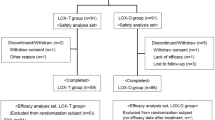Summary
A prospective, randomized, multicentre, open, crossover study of the comparative efficacy, tolerability and acceptability of two topical nonsteroidal anti-inflammatory drug (NSAID) therapies, flurbiprofen local-action transcutaneous (LAT) patch (40 mg b.d.) and piroxicam gel (3 cm, 0.5% q.d.s), was conducted in general practice in the UK in 137 men and women with soft-tissue rheumatism of the shoulder or elbow (e.g. epicondylitis, tendinitis, bursitis and adhesive capsulitis). Patients received one therapy for 4 days before crossing over to the other NSAID for a further 4 days, followed by 6 days of their preferred therapy. Clinical assessment of severity of pain, tenderness and overall clinical condition was carried out at baseline and after 4, 8 and 14 days. Patients self-assessed the severity of pain during the day and at night, and also the quality of their sleep during each treatment phase.
More patients showed a greater improvement in all of the clinical assessments of efficacy following treatment with flurbiprofen LAT during the crossover phase. There was a statistically significant reduction in the severity of pain, the principal measure of efficacy, in favour of flurbiprofen LAT: 42% of patients showed greater improvement with flurbiprofen LAT compared with 26% who showed a greater improvement with piroxicam gel (p=0.012; n=131, intent-to-treat). Eligible dataset (n=126) analysis revealed statistically significant differences in favour of flurbiprofen LAT in the severity of lesion tenderness (p=0.03) and the overall change in clinical condition (p=0.04) compared with baseline status. Superior efficacy for flurbiprofen LAT was also indicated in the patients' assessment at the end of the crossover phase (day 8), at which 69% chose to continue treatment with flurbiprofen LAT compared with only 31% of patients who chose piroxicam gel (n=126; p<0.001). There were, in addition, statistically significant differences in favour of flurbiprofen LAT in assessments for night pain (p<0.001), quality of sleep (p=0.004) and the patients' overall opinion of treatment (p<0.001). Both treatments were well tolerated with a low incidence of mainly local adverse events. These results showed that flurbiprofen LAT had a greater efficacy than piroxicam gel, and was also preferred by patients in the treatment of painful soft-tissue rheumatism of the shoulder and elbow.
Similar content being viewed by others
References
Famaey, J.P. Correlation of plasma levels, NSAID and therapeutic response. Clin Rheumatol 1985, 4, 124–132.
Radermacher, J., Jentsch, D., Scholl, M.A., Lustinetz, T., Frölich, J.C. Diclofenac concentrations in synovial fluid and plasma after cutaneous application in inflammatory and degenerative joint disease. Br J Clin Pharmacol 1991, 31, 537–541.
Ginsberg, F., Famaey, J.P. Double-blind, randomized crossover study of the percutaneous efficacy and tolerability of a topical indomethacin spray versus placebo in the treatment of tendinitis. J Int Med Res 1991, 19, 131–136.
Bouchier-Hayes, T.A., Rotman, H., Darekar, B.S. Comparison of the efficacy and tolerability of diclofenac gel (Voltarol Emulgel) and felbinac gel (Traxam) in the treatment of soft tissue injuries. Br J Clin Pract 1990, 44, 19–20.
Atra, E., Metz, C.A., Brown, B.L., Teoh, K. Flurbiprofen versus diclofenac for the treatment of osteoarthritis of the knee. Ann Pharmacother 1990, 24, 920–923.
Stubbs, D.F., Freeman, B.E., Jonson, J.H. Efficacy of flurbiprofen for non-arthritic pain. Curr Ther Res 1989, 46, 1179–1195.
Grant, M., Walter, J., Wojtulewski, J.A. A double-blind parallel group comparison of flurbiprofen and indomethacin in the long term treatment of osteoarthrosis of the knee. Br J Clin Pract 1980, 37, suppl 9, 92–94.
Buchanan, W.W., Kassam, Y.B. European experience with flurbiprofen. A new analgesic, anti-inflammatory agent. Am J Med 1986, 80, 145–152.
Taburet, A.M., Singlas, E. Pharmacokinetic comparison of oral and local action transcutaneous flurbiprofen in healthy volunteers. J Clin Pharm Ther 1995, 20, 101–107.
Sugawara, S. A study of the concentration in the synovial fluid and tissues of patients treated with the transdermal topical application of flurbiprofen (FP-A). Therap Res 1987, 6, 289–294.
Poul, J., West, J., Buchanan, N., Grahame, R. Local action transcutaneous flurbiprofen in the treatment of soft tissue rheumatism. Br J Rheumatol 1993, 32, 1000–1003.
Memeo, A., Garofoli, F., Peretti, G. Evaluation of the efficacy and tolerability of a new topical formulation of flurbiprofen in acute soft tissue injuries. Drug Invest 1992, 4, 441–449.
Aoki, T., Sugawara, S., Fujimaki, Y. et al. Clinical evaluation of topical application of flurbiprofen (FP-A) as a treatment for periarthritis scapulohumeralis-collaborative double-blind test compared with the control. Jap J Inflamm 1989, 9, 335–344.
Russell, A.L. Piroxicam 0.5% topical gel compared to placebo in the treatment of acute soft tissue injuries: a double-blind study comparing efficacy and safety. Clin Invest Med 1991, 14, 35–43.
Hills, M., Armitage, P. The two-period cross-over clinical trial. Br J Clin Pharmacol 1979, 8, 7–20.
Hollander, M., Wolfe, D.A. Nonparametric Statistical Methods. New York: Wiley, 1973, 67–75.
Armitage, P., Berry, G. Statistical Methods in Medical Research, 2nd ed. Oxford: Blackwell, 1987, 106–108.
Shapiro, S.S., Wilk, M.B. An analysis of variance test for normality (complete samples). Biometrika 1965, 52, 591–611.
Brown, M.B., Forsyth, A.B. Robust tests for the equality of variances. J Am Stat Assoc 1974, 69, 364–367.
Armitage, P., Berry, G. Statistical Methods in Medical Research, 2nd ed. Oxford: Blackwell, 1987, 120–123.
Kay, E., Petty, D. Topical NSAIDs. Curr Pract Pharm Ther, 1991, 3(8), 5–7.
Author information
Authors and Affiliations
Additional information
On behalf of the General Practice Research Group: P.J.M. Milroy, P. Roylance, G. Hamilton, F.G. De, L. Wright, M.M.G.B. Scott, S. R. Fisher, B.A. Hakin, P.A. Vakil, J.A.G. Jones.
Rights and permissions
About this article
Cite this article
Ritchie, L.D. A clinical evaluation of flurbiprofen LAT and piroxicam gel: A multicentre study in general practice. Clin Rheumatol 15, 243–247 (1996). https://doi.org/10.1007/BF02229701
Received:
Accepted:
Issue Date:
DOI: https://doi.org/10.1007/BF02229701




